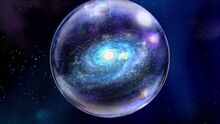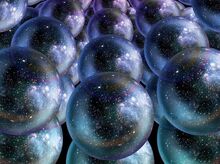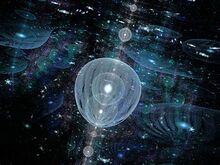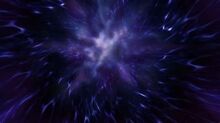Description[]
In physics, three dimensions of space and one of time is the accepted norm. However, there are theories that attempt to unify the four fundamental forces by introducing extra dimensions. Most notably, superstring theory requires 10 space-time dimensions, and originates from a more fundamental 11-dimensional theory tentatively called M-theory which subsumes five previously distinct superstring theories. To date, no experimental or observational evidence is available to support the existence of these extra dimensions. If extra dimensions exist, they must be hidden from us by some physical mechanism. One well-studied possibility is that the extra dimensions may be "curled up" at such tiny scales as to be effectively invisible to current experiments. Limits on the size and other properties of extra dimensions are set by particle experiments
Dimensions Explained[]
The 0th dimension: A single point that cannot move has no length, height or width, and is infinitely small. Every point is exactly the same and has the same measurements, because it has no real dimensional scale
The 1st dimension: The first dimension is considered length. The best way to talk about the first dimension would be to visualize a line that stretches infinitely, going from point A to point B. This line only has length but no width.
The 2nd dimension: If you take the infinite line- the 1st dimension and add height, or a y-axis, you will get the 2nd dimension; producing a 2nd dimensional object like a square or a triangle. However, the line that was produced in the 1st dimension will not exist in a 2 dimensional plane because it has no height.
The 3rd dimension: Otherwise known as space, the third dimension would be adding depth on top of the infinite 2nd dimensional square. In doing this, you would create objects with volume such as a cube or a sphere, that are not infinite in size, but can become so. We human's are 3rd dimensional beings, and thus we cannot perceive anything higher than the 3rd dimension.
The 4th dimension: The 4th dimension is generally considered to be time. Time is used to explain how someone or something went from point A to point B. In fiction, there are beings who are 4th dimensional by only existing in one point in time, and being unbound by the very concept. There are however, beings who have 4th dimensional powers, but still exists within the 3rd dimensional plane.
The 5th dimension: The 5th dimension has to do with the idea of parallel worlds. It is believed there are multiple universes, and this collection of universes creates a multiverse. According to some development upon Einsteins theory of relativity, a 5th dimensional space can contains an infinite number of 4th dimensional time within it. Furthermore, a general definition of the 5th dimension depicts that it is a dimension unseen by humans where the forces of gravity and electromagnetism unite to create a simple but graceful theory of the fundamental forces. In fiction,a 5th dimensional being tends to transcend infinite universes and thus transcends space and time as concepts.
Even higher dimensions: This continues on for infinity. There is theory upon a 6th dimension, which is given to beings in fiction who infinitely transcend the 5th dimension. This continues on endlessly, until it reaches Hilbert space, which is the theory of infinite higher dimensional space.
Beyond the concept of dimensions: There are some beings who are dimensionless. These beings are without dimensions, or transcend the very concepts of dimensions themselves. They are typically Nigh-Omnipotent or omnipotent in their own right and cannot be explained in conventional means. In order to be beyond the concept of dimensions, a character would need to be beyond logic, comprehension, science and of course dimensions
Pocket Dimesnions[]
Pocket dimensions are personal dimensions owned by individuals or exist naturally. Some that own these dimensions have the power to manipulate reality there and can be nearly unstoppable while within them.
Universe[]

The universe is defined as all existing matter and space as a whole. This includes but isn't limited to moons, stars, solar systems and galaxies. Depending on the fiction, the universe and everything inside it can vary in size. An example would be that each of the 12 universes in Dragon Ball are infinite in size, and contain an infinite amount of galaxies, which contain countless amounts of Solar Systems and Stars. If you include the 4th dimension of time in a universe, you get a timeline.
Multiverse[]

The most popular mention of the multiverse comes from the multiverse theory. From it, we learn about the possible existence of multiple parallel universes; these universes together create a multiverse. Each multiverse ranges in sizes depending on the fiction in question, some can have 2 universes, and some infinite. Both of these would still mean the fiction is a multiverse, as it fits within the official definition. Obviously, a fiction can have a multiverse via a large number of timelines, as universes are within 4th dimensional timelines.
Hyperverse[]

The term Hyperverse comes from the worlds "hyper", which in math is used to talk about higher dimensional spaces. A fiction can only be described as a hyperverse if there are 12 higher dimensional spaces, all the way up to an infinite amount, which is known as Hilbert space.
Omniverse[]

The term "omniverse" tends to be quite subjective, as it is the collection of everything throughout creation, existence and non-existence etc. Technically, even if a fiction only has 1 or 2 universes, it can still be considered an omniverse, just really small in stature to a "true omniverse". In the case of Marvel or DC Comics, the "omniverse" is the collection of all infinite universes and higher dimensional spaces, while in many other verses it's the collection of all universes and timelines.
Outerverse[]

The outerverse is a place beyond the concept of creation and existence.
Meta-Fiction[]
Meta-Fiction is fictional verses within fictional verses. One universe is treated as fictional within another universe . An example of this is how the Monitors of DC view the events of creation as fictional, and how the people of Hero Town in Dragon Ball view the Dragon Ball universe as fictional.
